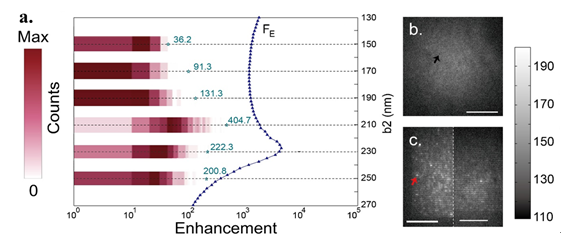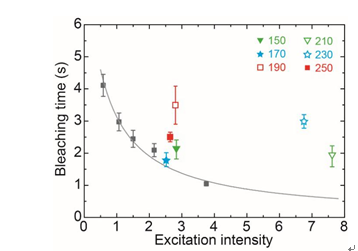(a) Schematic of double-bar nano-antenna coated with AIEE1000 molecules (black double ended arrows) in PMMA (light blue) on glass substrate (light grey). Inset shows the chemical structure of AIEE1000. (b-g) SEM images of fabricated nano-antennas with different bar-lengths. Credit: Wenqi Zhao, Xiaochaoran Tian, Zhening Fang, Shiyi Xiao, Meng Qiu, Qiong He, Wei Feng, Fuyou Li, Yuanbo Zhang, Lei Zhou, and Yan-Wen Tan
NIR fluorescence has shown great potential in bioscience, but low quantum-yield has largely impeded research on most NIR fluorophores. Here, scientists in China use asymmetric plasmonic nano-antennas to drastically enhance an NIR dye's single-molecule fluorescence intensity. The asymmetry provides an additional tuning parameter that offers new possibilities to modulate near-field and far-field properties of the plasmonic modes, thereby improving fluorescence without compromising the molecule's photostability. This work provides a universal scheme for engineering NIR single-molecule fluorescence.
Single-molecule fluorescence detection (SMFD) is able to probe, one molecule at a time, dynamical processes that are crucial for understanding functional mechanisms in biosystems. Fluorescence in the near-infrared (NIR) offers improved signal to noise ratio (SNR) by reducing the scattering, absorption and autofluorescence from biological cellular or tissue samples, and therefore, provides high imaging resolution with increased tissue penetration depths that are important for biomedical applications. However, most NIR-emitters suffer from low quantum yield and the weak NIR fluorescence signal makes the detection extremely difficult.
Plasmonic nanostructures are capable of converting localized electromagnetic energy into free radiation and vice versa. This capability makes them efficient nano-antennas for modulating molecular fluorescence. The plasmonic nano-antenna generally enhances the fluorescence of a nearby molecule by enhancing the excitation rate and the quantum yield of the molecule. In order to optimally enhance the fluorescence, the plasmonic mode of the nano-antenna has to 1) couple strongly to the molecule and 2) radiate strongly to free space. Simultaneously satisfying the two requirements poses a challenge that is impossible to overcome in conventional, symmetric plasmonic nanostructures.
(a) Histogram of fluorescence enhancement with asymmetric double-bar antennas. Each histogram shows the distribution of fluorescence enhancement coming from molecules near asymmetric double-bar antennas with different bar-lengths. Maximums of simulated enhancement are indicated with blue dash-dotted lines (b) Fluorescence image of AIEE1000 in PMMA without antennas. (c) Fluorescence image of asymmetric antenna (left-half) and symmetric antenna (right-half) array coated with AIEE1000 in PMMA. Credit: Wenqi Zhao, Xiaochaoran Tian, Zhening Fang, Shiyi Xiao, Meng Qiu, Qiong He, Wei Feng, Fuyou Li, Yuanbo Zhang, Lei Zhou, and Yan-Wen Tan
In a new paper published in Light Science & Applications, scientists from the State Key Laboratory of Surface Physics, Physics Department of Fudan University, China, establishes a novel, universal approach to enhance single-molecule fluorescence in the NIR regime without compromising the molecule's photostability.
They construct asymmetric nano-antennas consisting of two bars with unequal lengths (Fig. 1) that provide multiple plasmonic modes with tunable resonance frequencies matching both excitation and emission frequencies of the fluorophore. The added tuning parameter, i.e., the ratio of the bar lengths, in such asymmetric structures offers new possibilities to modulate the near-field and far-field properties of the plasmonic modes, thereby further improving both excitation and emission processes. As a result, they experimentally acquire a single-molecule fluorescence enhancement factor up to 405 (Fig. 2), and the corresponding theoretical calculations indicate the quantum yield can be as high as 80%. Because the quantum yield plays a major role in this setup, this enhancement is achieved without sacrificing the molecules' survival time under laser irradiation.
Measurement of bleaching time on glass as a function of excitation power density displays an inverse proportional relationship (grey squares and grey line). While bleaching time of molecules on antenna-array are all longer than corresponding ones on glass (color symbols represent bleaching times on corresponding structure). Credit: Wenqi Zhao, Xiaochaoran Tian, Zhening Fang, Shiyi Xiao, Meng Qiu, Qiong He, Wei Feng, Fuyou Li, Yuanbo Zhang, Lei Zhou, and Yan-Wen Tan
In addition, compared with reference groups of molecules located on glass substrate, the authors have observed a significantly increased photobleaching time in molecules located around asymmetric double-bar nano-antennas (Fig. 3), indicating a much higher number of fluorescence photons emitted by those molecules. The nano-antennas are, therefore, able to drastically suppress photobleaching. Because the local field enhancement does not improve photostability, the suppression comes mainly from the increased quantum yield as a result of competition between photobleaching rate and energy transfer rate to antenna.
More information: Wenqi Zhao et al, Engineering single-molecule fluorescence with asymmetric nano-antennas, Light: Science & Applications (2021). DOI: 10.1038/s41377-021-00522-9
Journal information: Light: Science & Applications
Provided by Chinese Academy of Sciences

























